To get a drone license for flying drones over 249 grams, like the DJI Air 3, register your drone on FAA DroneZone and clearly label it with your unique registration number—think of it as your drone’s nametag! If you’re under 16, you’ll need to wait, but everyone else should study for and pass the FAA Part 107 test, which covers airspace rules, safety, and weather. Proof of registration is required for each flight, so don’t misplace it! Ready for the next steps?
Key Takeaways
- Register your drone over 249g with the FAA through the DroneZone website, paying a $5 fee valid for three years.
- Study for and pass the FAA Part 107 Aeronautical Knowledge Test to earn a Remote Pilot Certificate for commercial use.
- Meet eligibility: be at least 16 years old, proficient in English, and mentally and physically fit to fly safely.
- Clearly mark your drone with its FAA registration number and carry proof of registration during all flights.
- Complete recurrent training or testing every two years to keep your Remote Pilot Certificate active and avoid penalties.
Understanding Drone Weight Classes and FAA Regulations
When it comes to flying drones, the Federal Aviation Administration (FAA) doesn’t just toss all drones into the same pile—weight actually matters a lot! If your drone tips the scale over 0.55 pounds (that’s 250 grams, or about the weight of a hamster), you’re entering a new world of rules and responsibilities. The FAA has set this threshold because heavier drones can cause more damage if something goes wrong, raising Insurance Implications and Liability Concerns for operators. For example, a drone over 250g flown for business must follow FAA Part 107 regulations, requiring extra safety steps. Even for recreational pilots, flying a larger drone means more attention to things like altitude limits, airspace restrictions, and yes, those all-important privacy considerations! Many drones under 249g, such as the DJI Mini 3, can avoid FAA registration and Remote ID requirements when flown recreationally due to weight and size restrictions.
Registering Your Drone Over 249G With the FAA
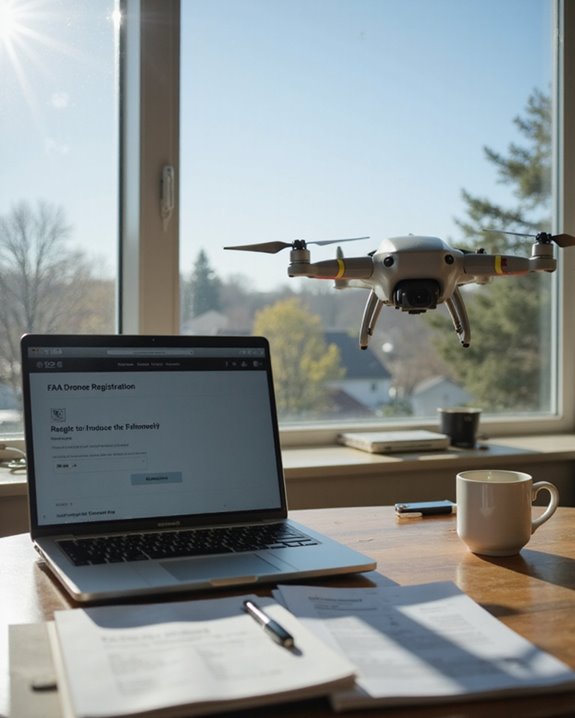
So, your drone weighs more than 249 grams—looks like you’ve graduated into the “big leagues” of drone flying! Now, you’ll need to complete FAA Online Registration before taking off. Head to the FAADroneZone (https://faadronezone-access.faa.gov/#/) and gather your drone’s make, model, your email, physical address, and phone number. The Fee Payment is just $5 per drone, valid for three years—cheaper than a burger combo! Credit or debit cards make it quick and simple. After registration, mark your drone with its unique number, right on the outside where it’s easy to see. Whether you use your drone for fun or business, carry proof of registration and keep up with FAA rules. Welcome to responsible drone ownership! Using premium drone registration stickers ensures the label stays visible and durable under various weather conditions.
Age and Eligibility Requirements for Drone Operators

Getting ready to fly a drone over 249 grams isn’t just about excitement and cool aerial shots—it also means meeting some important age and eligibility rules! Youth requirements are clear: you must be at least 13 years old to register your drone, but to get a real drone license, like the FAA’s Remote Pilot Certificate, you need to be at least 16. Health eligibility is just as essential; you have to be physically and mentally fit to fly safely (no drones for sleepyheads!). Plus, you need to read, speak, write, and understand English well. These requirements make sure everyone in the sky is responsible and safe. Remember, meeting these rules isn’t just paperwork—it’s about protecting you, your drone, and everyone below! Additionally, drones like the DJI Air 3 must comply with the FAA Remote ID rule, which may affect licensing requirements.
Overview of Part 107 Certification for Commercial Use
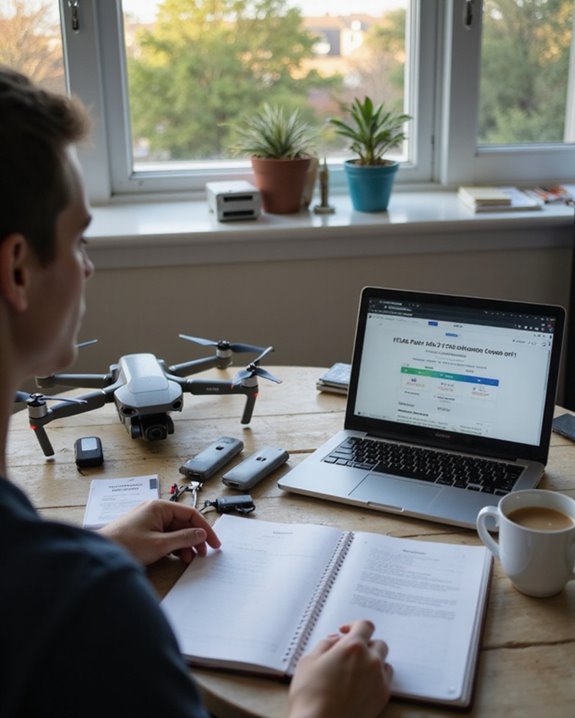
A new chapter opens for drone enthusiasts who want to turn their flying hobby into a real job—enter the world of Part 107 certification! Anyone hoping to fly drones commercially in the U.S. needs a Remote Pilot Certificate from the FAA. The rules are clear: your drone must weigh under 55 pounds, be registered, and follow strict airspace and safety regulations. Even if you’re already a pilot, there are special requirements to shift smoothly to Part 107 operations. Compared to global standards, the U.S. has some of the most detailed commercial drone rules. Future Trends point toward more automation and tighter Remote ID rules, so staying updated is essential. Think of Part 107 as your golden ticket to serious, legal drone business—no shortcuts allowed!
Preparing for the FAA Aeronautical Knowledge Test
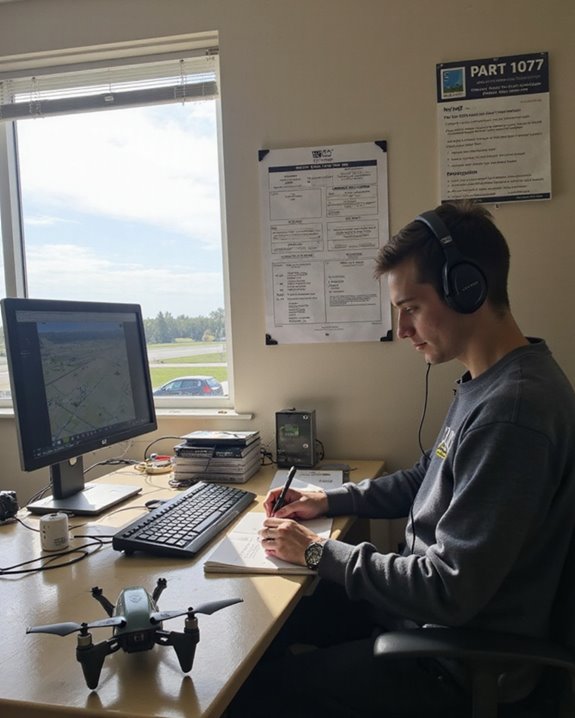
Preparing for the FAA Aeronautical Knowledge Test feels a bit like gearing up for a secret agent mission—only instead of spy gadgets, you’ll need study guides and a sharp mind! The test covers areas such as airspace classifications, weather impacts, drone performance, and those all-important Part 107 regulations. Candidates must be at least 16, proficient in English, and in good physical and mental shape. Start your mission by registering for an FAA Tracking Number (FTN) through IACRA. Grab reliable study guides like the FAA’s “Remote Pilot – Small UAS Study Guide,” and develop exam strategies—think practice tests, flash cards, and reviewing tricky topics. Scheduling your test at an approved center and bringing a government-issued ID is essential. Preparation really is your license to fly!
Completing the TRUST Test for Recreational Flyers
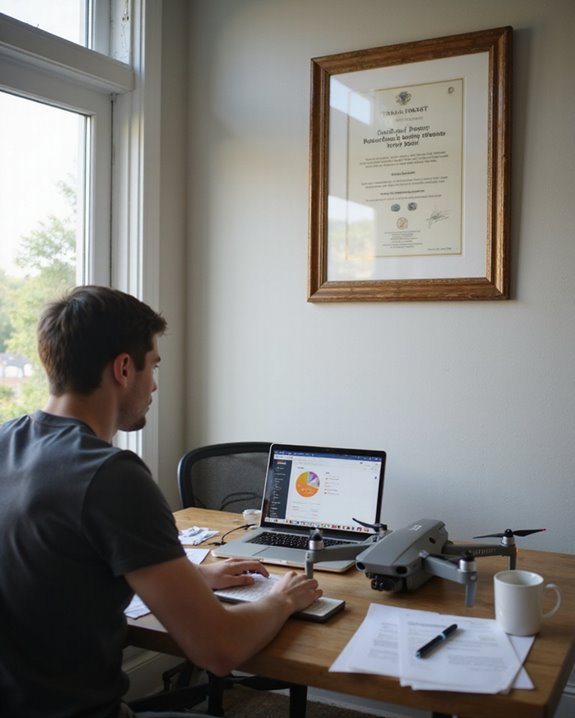
For anyone excited to take to the skies with a drone just for fun, the TRUST test is an absolute must! Before your first flight, test preparation couldn’t be easier—TRUST is free, online, and available through FAA-approved Test Administrators, such as educational websites. The test covers safety rules and regulations, with unlimited attempts to get all the multiple-choice answers right—no trick questions or pop quizzes here! After passing, you’ll immediately receive a certificate. Here’s the catch: certificate maintenance is vital. The FAA and Test Administrators don’t keep records, so if you lose it, you’ll need to retake the test. Store your printed or digital certificate somewhere safe—maybe not taped to your drone, but somewhere you’ll remember!
Marking and Labeling Your Drone With the Registration Number
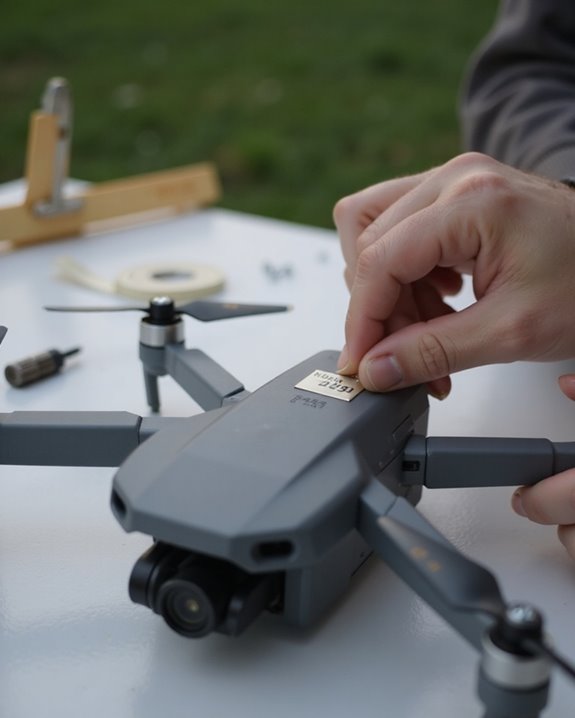
Even before your drone takes its first spin above the treetops, marking it with your FAA registration number is an essential step that simply can’t be skipped! The FAA requires that every drone over 249g has its registration number clearly visible, so grab those Sticker Options and get creative—but keep it readable. Most pilots choose to place the sticker on the top or side of the drone’s hull, or maybe on the propeller arms for easy Label Maintenance. If you’re feeling fancy, you might even tuck the number inside a battery compartment, as long as no tools are needed to see it. Remember, a smudged or peeling sticker is a compliance no-go, so check the label before every flight—think of it as your drone’s ID badge!
Navigating Controlled Airspace and LAANC Authorization
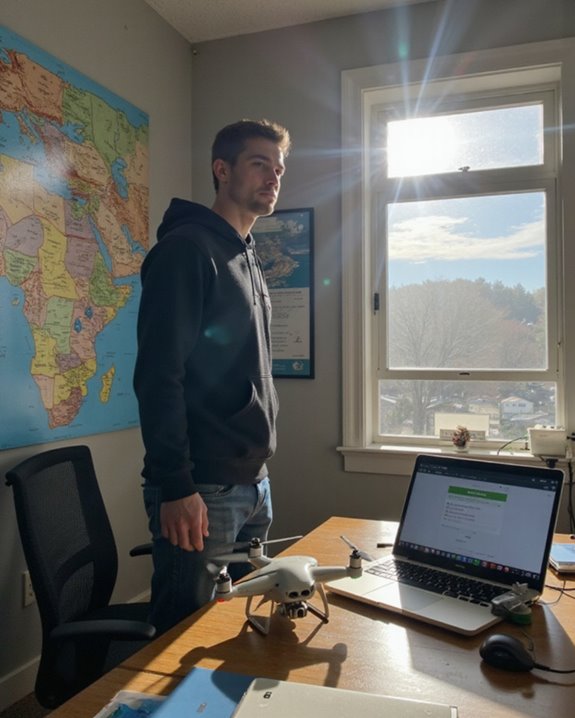
Once your drone is sporting its shiny new registration label, the next hurdle is understanding where you can actually fly—because not every patch of sky is open for takeoff! Controlled airspace, like the invisible bubble above airports or busy cities, has a long Airspace History rooted in keeping the skies safe for everyone. To get clearance for your drone adventure, the FAA’s LAANC system is your best friend, offering quick, almost instant approval through apps like AirMap or Kittyhawk. But don’t forget—there are LAANC Alternatives, such as directly applying for waivers if you need special permissions. Always use UAV mapping tools to spot those no-fly zones. With the right know-how, you’ll avoid accidental “sky trespassing” and keep your flying fun and legal!
Operating Your Drone Safely Within Legal Airspace Limits
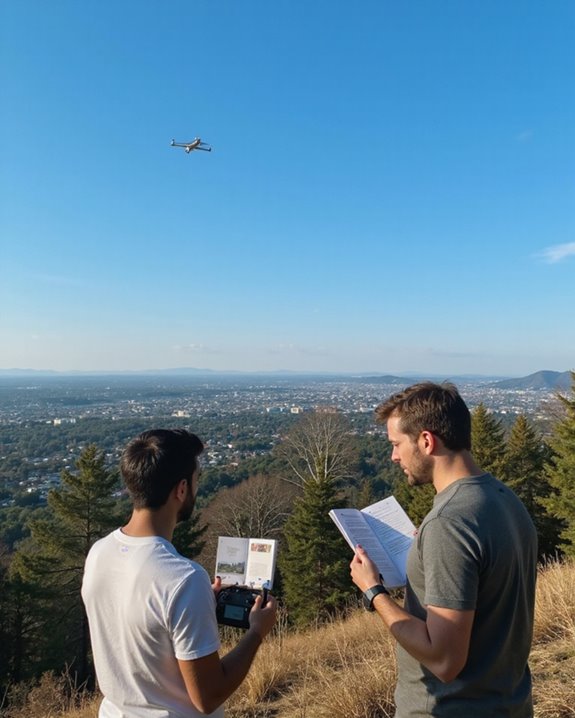
Take to the skies with confidence by mastering the rules that keep both your drone and everyone below safe! Always keep your drone within sight—visual monitoring is not just smart, it’s required. Don’t let your drone wander off like a curious puppy! Use assistant spotters to help keep an eye out in tricky areas or low light. Check the FAA’s B4UFLY app before takeoff; it’s your go-to for no-fly zones like airports or national parks. Remember, altitude matters—stay below 400 feet in uncontrolled airspace. Weather awareness is also key; fog, rain, or strong winds can quickly spoil your flight and make visual monitoring tough. Finally, always yield to manned aircraft and avoid flying over crowds or wildlife.
Keeping Your Drone Registration and Pilot Certification Current
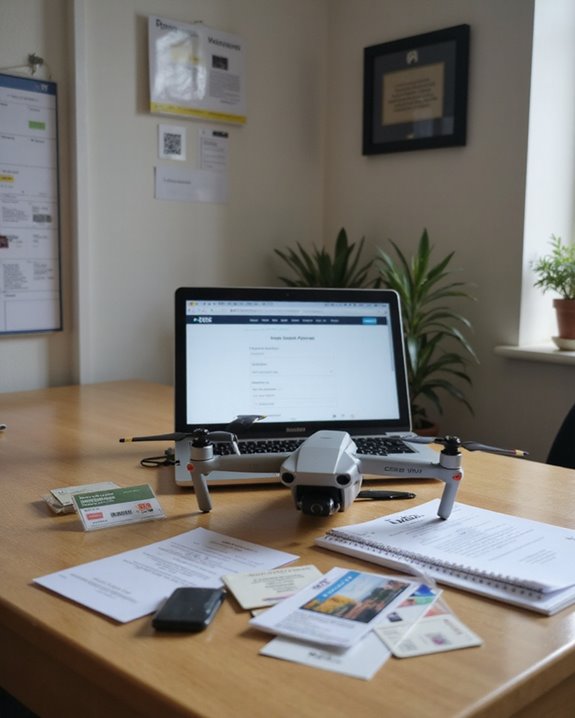
Mastering safe flight habits is only half the battle—keeping your paperwork in order is just as important! Drone pilots must pay attention to renewal reminders, whether flying for fun or profit. Recreational drone registration costs just $5 and lasts three years—easy to forget, but even easier to renew on the FAA DroneZone website. Commercial pilots, get ready for a little more red tape; Part 107 certificates expire every two years, requiring recurrent training or a knowledge test. Lapse consequences? Operating with expired paperwork can lead to fines or grounding—definitely not the adventure you want! Pro tip: Keep those registration numbers visible on your drone and watch your email for renewal reminders from the FAA. Stay sharp, stay legal, and keep flying high!
Frequently Asked Questions
Can I Fly a Drone Over 249G Internationally With My FAA Registration?
Like a passport that opens some but not all borders, FAA registration alone does not permit International Flying. When flying FAA Overseas, drone operators must comply with each country’s unique drone laws and registration requirements.
What Happens if I Lose My Drone Registration Certificate?
If a drone operator loses their registration certificate, replacement options are available through the FAA’s online portal or by mail. Certificate reissue is straightforward, with details stored online, and physical documentation is not required for legal flight operations.
Are There Insurance Requirements for Drones Over 249G?
While federal law does not mandate insurance for drones over 249g, commercial operators often face insurance requirements or client demands. Insurance options include liability and hull coverage, with coverage limits varying by policy, provider, and operational risk.
Can Multiple People Operate the Same Registered Drone?
Shared control of a single registered drone is permitted under operator sharing rules, provided each operator holds a remote pilot certificate. Each person must follow safety protocols, possess registration proof, and guarantee compliance with licensing and operational requirements.
What Penalties Exist for Flying an Unregistered Drone Over 249G?
Flying an unregistered drone over 249g may net operators the “honor” of hefty fine levels—up to $18,200—and potential criminal repercussions. The FAA’s seriousness guarantees those ignoring registration requirements face more than just a slap on the wrist.





